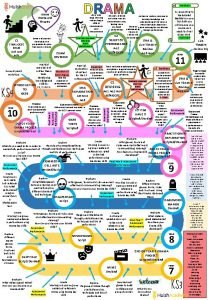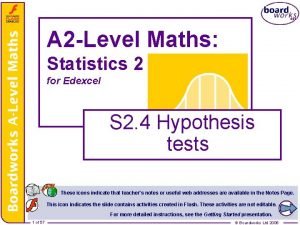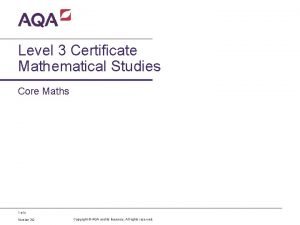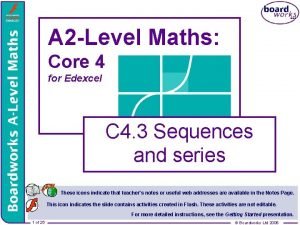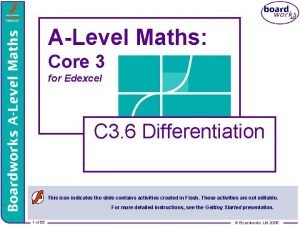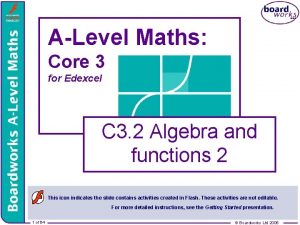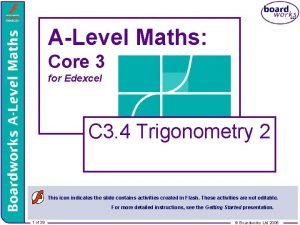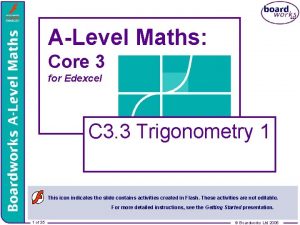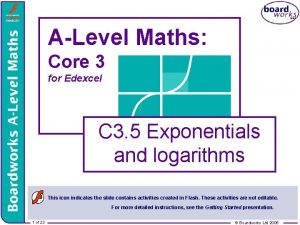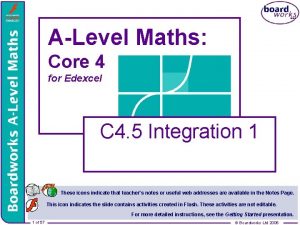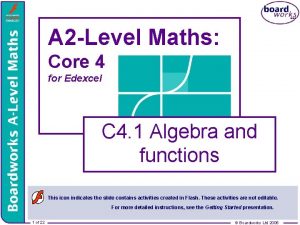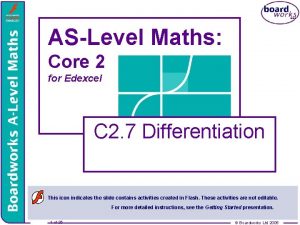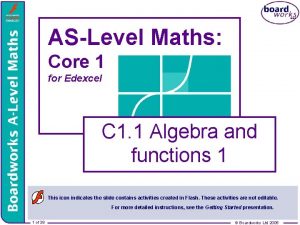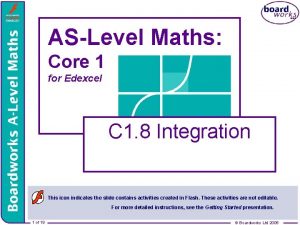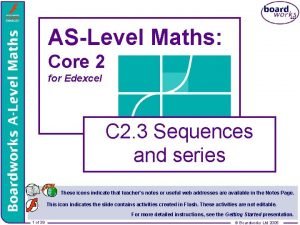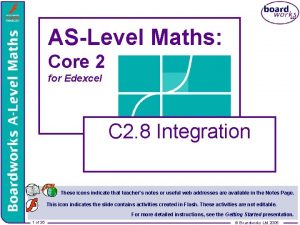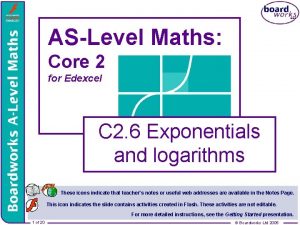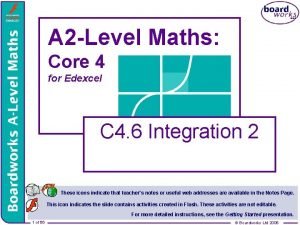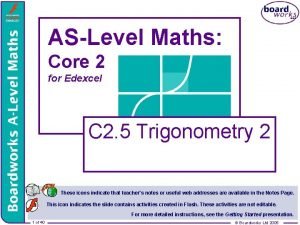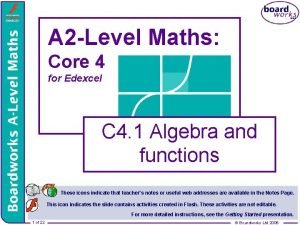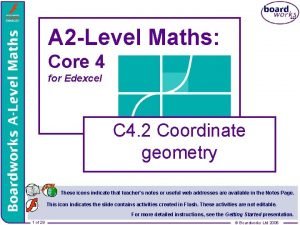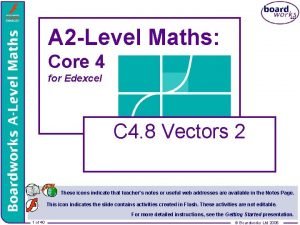ALevel Maths Core 4 for Edexcel C 4

























































- Slides: 57

A-Level Maths: Core 4 for Edexcel C 4. 5 Integration 1 These icons indicate that teacher’s notes or useful web addresses are available in the Notes Page. This icon indicates the slide contains activities created in Flash. These activities are not editable. For more detailed instructions, see the Getting Started presentation. 1 of 57 © Boardworks Ltd 2006

Integrals of standard functions Contents Integrals of standard functions Reversing the chain rule Integration by substitution Integration by parts Volumes of revolution Examination-style question 2 of 57 © Boardworks Ltd 2006

Review of integration So far, we have only looked at functions that can be integrated using: For example: Integrate 3 of 57 with respect to x. © Boardworks Ltd 2006

The integral of The only function of the form xn that cannot be integrated by this method is x– 1 =. Adding 1 to the power and then dividing would lead to the meaningless expression, This does not mean that cannot be integrated. Remember that Therefore 4 of 57 © Boardworks Ltd 2006

The integral of We can only find the log of a positive number and so this is only true for x > 0. However, does exist for x < 0 (but not x = 0). So how do we integrate it for all possible values of x? We can get around this by taking x to be negative. If x < 0 then –x > 0 so: We can combine the integrals of using the modulus sign to give: 5 of 57 for both x > 0 and x < 0 by © Boardworks Ltd 2006

The integral of Find This is just the integral of multiplied by a constant. Find 6 of 57 © Boardworks Ltd 2006

Definite integrals involving It is particularly important to remember the modulus sign when evaluating definite integrals of functions involving. Find the area under the curve y = – between x = – 3, x = – 1 and the x-axis, writing your answer in the form ln a. y The area is given by – 3 – 1 0 . x Remember that ln 1 = 0 units squared 7 of 57 © Boardworks Ltd 2006

Definite integrals involving We should note that definite integrals of the form can only be evaluated if x = 0 does not lie in the interval [a, b]. 8 of 57 © Boardworks Ltd 2006

Integrals of standard functions By reversing the process of differentiation we can derive the integrals of some standard functions. These integrals should be memorized. 9 of 57 © Boardworks Ltd 2006

Integrals of standard functions Also, if any function is multiplied by a constant k then its integral will also be multiplied by the constant k. Find In practice most of these steps can be left out. 10 of 57 © Boardworks Ltd 2006

Reversing the chain rule Contents Integrals of standard functions Reversing the chain rule Integration by substitution Integration by parts Volumes of revolution Examination-style question 11 of 57 © Boardworks Ltd 2006

Reversing the chain rule A very helpful technique is to recognize that a function that we are trying to integrate is of a form given by the differentiation of a composite function. This is sometimes called integration by recognition. Let By the chain rule: So It follows that for n ≠ 1 12 of 57 © Boardworks Ltd 2006

Reversing the chain rule If the integral is multiplied by a constant k: Don’t try to learn this formula, just try to recognize that the function you are integrating is of the form k(f(x))n f ’(x) and compare it to the derivative of (f(x))n + 1. Suppose we want to integrate (2 x + 7)5 with respect to x. Consider the derivative of y = (2 x + 7)6. Using the chain rule: = 12(2 x + 7)5 So 13 of 57 © Boardworks Ltd 2006

Reversing the chain rule In general, you can integrate any linear function raised to a power using the formula: With practice, integrals of this type can be written down directly. For example: 14 of 57 © Boardworks Ltd 2006

Reversing the chain rule Let’s look at some more integrals of functions of the form k(f(x))n f ’(x). Integrate y = x(3 x 2 + 4)3 with respect to x. Notice that the derivative of 3 x 2 + 4 is 6 x. Now consider the derivative of y = (3 x 2 + 4)4. Using the chain rule: = 24 x(3 x 2 + 4)3 So 15 of 57 © Boardworks Ltd 2006

Reversing the chain rule Find . Notice that the derivative of 2 x 3 – 9 is 6 x 2. Now consider the derivative of y = (2 x 3 – 9)3. Using the chain rule: = 18 x 2(2 x 3 – 9)2 So 16 of 57 © Boardworks Ltd 2006

Reversing the chain rule Find . Start by writing x 2 is the derivative of (x 3 – 1). as plus 1 is Now consider the derivative of y = Using the chain rule: So 17 of 57 © Boardworks Ltd 2006

Reversing the chain rule for exponential functions When we applied the chain rule to functions of the form ef(x) we obtained the following generalization: We can reverse this to integrate functions of the form k f ’(x)ef(x). For example: A numerical adjustment is usually necessary. 18 of 57 © Boardworks Ltd 2006

Reversing the chain rule for exponential functions In general, Find . 19 of 57 © Boardworks Ltd 2006

Reversing the chain rule for exponential functions With practice, this method can be extended to cases where the exponent is not linear. For example: Find . Notice that the derivative of 2 x 2 is 4 x and so the function we are integrating is of the form k f ’(x)ef(x). 20 of 57 © Boardworks Ltd 2006

Reversing the chain rule for logarithmic functions When we applied the chain rule to functions of the form ln f(x) we obtained the following generalization: We can reverse this to integrate functions of the form For example: Remove a factor of to write the function in the form. In general, 21 of 57 © Boardworks Ltd 2006

Reversing the chain rule for logarithmic functions Find This is now of the form. . Evaluate , writing your answer in the form a ln b. First of all, note that the graph of y = has a discontinuity when 2 x – 7 = 0, that is when x = 3. 5. This is outside the interval [– 1, 2] and so the integral is valid. 22 of 57 © Boardworks Ltd 2006

Reversing the chain rule for logarithmic functions This is now of the form. This can be written in the required form by using the rule that ln a – ln b = ln. 23 of 57 © Boardworks Ltd 2006

Reversing the chain rule for logarithmic functions Find . 24 of 57 This is now of the form. © Boardworks Ltd 2006

The integral of tan x We can find the integral of tan x by writing it as recognizing that this fraction is of the form and. It is ‘tidier’ to rewrite this without a minus sign at the front, using the fact that –ln a = ln a– 1: 25 of 57 © Boardworks Ltd 2006

Reversing the chain rule for trigonometric functions When we applied the chain rule to functions of the form sin f(x) and cos f(x) we obtained the following generalizations: We can reverse these to integrate functions of the form f ’(x) cos f(x) and f ’(x) sin f(x). For example: 26 of 57 © Boardworks Ltd 2006

Reversing the chain rule for trigonometric functions As with other examples a numerical adjustment is often necessary. This is now of the form –f ’(x) sin f(x). In general, when dealing with the cos and sin of linear functions: 27 of 57 © Boardworks Ltd 2006

Integration by substitution Contents Integrals of standard functions Reversing the chain rule Integration by substitution Integration by parts Volumes of revolution Examination-style question 28 of 57 © Boardworks Ltd 2006

Integration by substitution With practice, the technique of integration by recognition can save a lot of time. However, when it is too difficult to use integration by recognition we can use a more formal method of reversing the chain rule called integration by substitution. To see how this method works consider the integral Let u = 5 x + 2 so that The problem now is that we can’t integrate a function in u with respect to x. We therefore need to write dx in terms of du. 29 of 57 © Boardworks Ltd 2006

Integration by substitution When we used the chain rule for differentiation we saw that we can treat informally as a fraction, so: So if u = 5 x + 2 and dx : Now change the variable back to x: 30 of 57 © Boardworks Ltd 2006

Reversing the chain rule for logarithmic functions Use a suitable substitution to find . Let u = 2 x 2 – 5 Substituting u and dx into the original problem gives: Notice that the x’s cancel out. 31 of 57 © Boardworks Ltd 2006

Integration by substitution Now we need to change the variable back to x : This integral could also have been found directly by recognition. However, there are functions that can be integrated by use of a suitable substitution but not by recognition. For instance: Use the substitution u = 1 – 2 x to find . If u = 1 – 2 x then 32 of 57 © Boardworks Ltd 2006

Integration by substitution Also if u = 1 – 2 x then We also have to substitute the x so that the whole integrand is in terms of u. Substituting these into the original problem gives: 33 of 57 © Boardworks Ltd 2006

Integration by substitution Changing the variable back to x gives: 34 of 57 © Boardworks Ltd 2006

Definite integration by substitution When a definite integral is found by substitution it is easiest to rewrite the limits of integration in terms of the substituted variable. Use the substitution u = y= to find the area under the curve between x = 4 and x = 7. If u = 35 of 57 then Using the chain rule for differentiation. © Boardworks Ltd 2006

Definite integration by substitution Now we need to find x in terms of u. If u = then u 2 = 8 – x x = 8 – u 2 Rewrite the limits in terms of u: when x = 3, when x = 1, The area is given by 36 of 57 . Rewrite this in terms of u: © Boardworks Ltd 2006

Definite integration by substitution Therefore, the required area is 37 of 57 units squared. © Boardworks Ltd 2006

Integration by parts Contents Integrals of standard functions Reversing the chain rule Integration by substitution Integration by parts Volumes of revolution Examination-style question 38 of 57 © Boardworks Ltd 2006

Integration by parts Suppose we wish to integrate the product of two functions, such as x sin x, where one of the functions is not related to the derivative of the other. An expression such as this can be integrated using the method of integration by parts. When we differentiate the product of two functions u and v we use the product rule: where u and v are functions of x. Integrating throughout with respect to x gives: 39 of 57 © Boardworks Ltd 2006

Integration by parts This can be rearranged to give: To integrate a product using this formula we let one part equal u and the other equal We find . by differentiating the part we called u. We find v by integrating the part we called It is important to choose u and so that is easier to integrate than 40 of 57 . . © Boardworks Ltd 2006

Integration by parts So, to integrate x sin x with respect to x: Let and differentiate So integrate and Now, using the formula 41 of 57 : We don’t need the “+ c” here. © Boardworks Ltd 2006

Integration by parts Find . Let and So and Now, apply the formula 42 of 57 : © Boardworks Ltd 2006

Integration by parts Find . We don’t know the integral of ln x so: let and so and Now, using the formula, 43 of 57 : © Boardworks Ltd 2006

The integral of ln x We can also use integration by parts to find the integral of ln x. We do this by writing ln x as (1 × ln x). Let and So and Now we can integrate by parts: 44 of 57 © Boardworks Ltd 2006

Integration by parts To evaluate a definite integral using integration by parts we use: Evaluate . Let and So and sin π/2 = 1 cos π/2 = 0 cos 0 = 1 45 of 57 © Boardworks Ltd 2006

Volumes of revolution Contents Integrals of standard functions Reversing the chain rule Integration by substitution Integration by parts Volumes of revolution Examination-style question 46 of 57 © Boardworks Ltd 2006

Volumes of revolution Consider the area bounded by the curve y = f(x), the x-axis and x = a and x = b. If this area is rotated 360° about the x-axis a three-dimensional shape called a solid of revolution is formed. The volume of this solid is called its volume of revolution. 47 of 57 © Boardworks Ltd 2006

Volumes of revolution We can calculate the volume of revolution by dividing the volume of revolution into thin slices of width δx. The volume of each slice is approximately cylindrical, of radius y and height δx, and is therefore approximately equal to πy 2δx 48 of 57 © Boardworks Ltd 2006

Volumes of revolution The total volume of the solid is given by the sum of the volume of the slices. The smaller δx is, the closer this approximate area is to the actual area. We can find the actual area by considering the limit of this sum as δx tends to 0. This limit is represented by the following integral: 49 of 57 © Boardworks Ltd 2006

Volumes of revolution So in general, the volume of revolution V of the solid generated by rotating the curve y = f(x) between x = a and x = b about the x-axis is: Similarly, the volume of revolution V of the solid generated by rotating the curve x = f(y) between y = a and y = b about the yaxis is: Volumes of revolution are usually given as multiples of π. 50 of 57 © Boardworks Ltd 2006

Volumes of revolution Find the volume of the solid formed by rotating the area between the curve y = x(2 – x), the x-axis, x = 0, and x = 2 360° about the x-axis. 51 of 57 © Boardworks Ltd 2006

Volumes of revolution Find the volume of the solid formed by rotating the area between the curve y = , the y-axis, y = 1, and y = 2 360° about the y-axis. Rearranging y = gives x =. 52 of 57 © Boardworks Ltd 2006

Examination-style question Contents Integrals of standard functions Reversing the chain rule Integration by substitution Integration by parts Volumes of revolution Examination-style question 53 of 57 © Boardworks Ltd 2006

Examination-style question a) Show that cos 2 x = (1 + cos 2 x) b) b) The diagram below shows the finite region R which is bounded by the curve y the x-axis, the y-axis and the line x =. y R c) d) 0 x Using the substitution x = sin u, or otherwise, find the area of the region R to 3 significant figures. c) Find the volume of the solid formed when R is rotated through 360° about the x-axis to 3 significant figures. 54 of 57 © Boardworks Ltd 2006

Examination-style question a) RHS = (1 + cos 2 x) Using the double angle identity cos 2 A ≡ 2 cos 2 A – 1. = (1 + (2 cos 2 x – 1)) = (2 cos 2 x) = cos 2 x = LHS b) The area of R is given by Using the substitution x = sin u we have: Find u when x is 0 and ½: when x = 0, u = 0 55 of 57 and when x = , u = © Boardworks Ltd 2006

Examination-style question Now make the substitution: Using the identity cos 2 A = 1 – sin 2 A. Using the identity cos 2 A = (1 + cos 2 A). Therefore, the area of region R is 0. 478 units squared (to 3 s. f. ). 56 of 57 © Boardworks Ltd 2006

Examination-style question c) The required volume of revolution is given by Therefore, the volume formed when R is rotated about the x-axis is 1. 44 units cubed (to 3 s. f. ). 57 of 57 © Boardworks Ltd 2006
 Edexcel alevel history
Edexcel alevel history Aqa a level physics data sheet
Aqa a level physics data sheet Drama alevel
Drama alevel Aqa alevel psychology
Aqa alevel psychology Gcse 1-9 pie charts answers
Gcse 1-9 pie charts answers Hypothesis testing a level maths
Hypothesis testing a level maths Fermi estimation core maths
Fermi estimation core maths Core 4 maths
Core 4 maths Inner core and outer core
Inner core and outer core Crust mantle core
Crust mantle core Basic layers of the earth
Basic layers of the earth Core capabilities and core rigidities
Core capabilities and core rigidities Borra hål för knoppar
Borra hål för knoppar Bris för vuxna
Bris för vuxna Mat för idrottare
Mat för idrottare Etik och ledarskap etisk kod för chefer
Etik och ledarskap etisk kod för chefer Publik sektor
Publik sektor Teckenspråk minoritetsspråk argument
Teckenspråk minoritetsspråk argument Ellika andolf
Ellika andolf Datorkunskap för nybörjare
Datorkunskap för nybörjare Fspos
Fspos Vad står k.r.å.k.a.n för
Vad står k.r.å.k.a.n för Steg för steg rita
Steg för steg rita Ministerstyre för och nackdelar
Ministerstyre för och nackdelar Redogör för vad psykologi är
Redogör för vad psykologi är Lek med geometriska former
Lek med geometriska former Bästa kameran för astrofoto
Bästa kameran för astrofoto Sju principer för tillitsbaserad styrning
Sju principer för tillitsbaserad styrning Nyckelkompetenser för livslångt lärande
Nyckelkompetenser för livslångt lärande Roliga rim till lärare
Roliga rim till lärare Personlig tidbok fylla i
Personlig tidbok fylla i Gibbs reflekterande cykel
Gibbs reflekterande cykel Antikt plagg
Antikt plagg Vilken grundregel finns det för tronföljden i sverige?
Vilken grundregel finns det för tronföljden i sverige? Verktyg för automatisering av utbetalningar
Verktyg för automatisering av utbetalningar Jätte råtta
Jätte råtta Plats för toran ark
Plats för toran ark Skivepiteldysplasi
Skivepiteldysplasi Romarriket tidslinje
Romarriket tidslinje Stig kerman
Stig kerman Informationskartläggning
Informationskartläggning Typiska novell drag
Typiska novell drag Varför kallas perioden 1918-1939 för mellankrigstiden?
Varför kallas perioden 1918-1939 för mellankrigstiden? Stål för stötfångarsystem
Stål för stötfångarsystem Tack för att ni har lyssnat
Tack för att ni har lyssnat Vishnuismen
Vishnuismen Cks
Cks Påbyggnader för flakfordon
Påbyggnader för flakfordon I gullregnens månad
I gullregnens månad Inköpsprocessen steg för steg
Inköpsprocessen steg för steg Strategi för svensk viltförvaltning
Strategi för svensk viltförvaltning Anatomi organ reproduksi
Anatomi organ reproduksi Egg för emanuel
Egg för emanuel Standardavvikelse formel
Standardavvikelse formel Rutin för avvikelsehantering
Rutin för avvikelsehantering Klassificeringsstruktur för kommunala verksamheter
Klassificeringsstruktur för kommunala verksamheter Myndigheten för delaktighet
Myndigheten för delaktighet Läkarutlåtande för livränta
Läkarutlåtande för livränta


